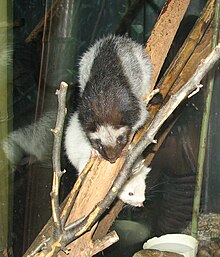
Rattus is a genus of muroid rodents, all typically called rats. However, the term rat can also be applied to rodent species outside of this genus.

Heteromyidae is a family of rodents consisting of kangaroo rats, kangaroo mice, pocket mice and spiny pocket mice. Most heteromyids live in complex burrows within the deserts and grasslands of western North America, though species within the genus Heteromys are also found in forests and their range extends down as far as northern South America. They feed mostly on seeds and other plant parts, which they carry in their fur-lined cheek pouches to their burrows.

The Old World rats and mice, part of the subfamily Murinae in the family Muridae, comprise at least 519 species. Members of this subfamily are called murines. In terms of species richness, this subfamily is larger than all mammal families except the Cricetidae and Muridae, and is larger than all mammal orders except the bats and the remainder of the rodents.
The name giant rat has been applied to various species of large rats and may refer to:

Emin's pouched rat, also known as the African pouched rat, is a large rat of the muroid superfamily. It is related to Cricetomys gambianus, the Gambian pouched rat. Both species belong to Cricetomys, the genus of the giant pouched rats.

Batomys is a genus of rodent endemic to the Philippines. It has six extant described species.

Tome's spiny rat, also known as Tomes' spiny rat or the Central American spiny rat, is a species of spiny rat distributed from Honduras to Ecuador. The IUCN has assessed its conservation status as being of "least concern".
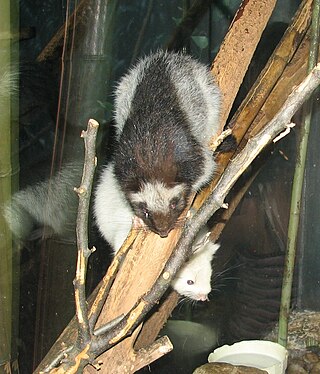
The cloud rats or cloudrunners are a tribe (Phloeomyini) of arboreal and nocturnal herbivorous rodents endemic to the cloud forests of the Philippines. They belong to the family Muridae and include five genera: Batomys, Carpomys, Crateromys, Musseromys, and Phloeomys. They range in size from as large as 50 cm (20 in) to as small as 74 mm (2.9 in). Cloud rats are threatened by habitat loss and illegal hunting. Several species are endangered or critically endangered.

The shrewlike rats, genus Rhynchomys, also known as the tweezer-beaked rats are a group of unusual Old World rats found only on the island of Luzon in the Philippines. They look a great deal like shrews and are an example of convergent evolution. Shrewlike rats evolved to be vermivores and insectivores feeding on soft-bodied invertebrates associated with leaf litter.

The Luzon montane forest mouse is a species of rodent in the family Muridae, from the genus Apomys. It occurs only in the Philippines, where it has been found on the large northern island Luzon. It is most closely related to the large Mindoro forest mouse, which occurs on Mindoro. There may be another related species in the Sierra Madre, but this species is yet undescribed. The Luzon montane forest mouse is a relatively large, ground-dwelling rat with a tail that is quite short for its genus.
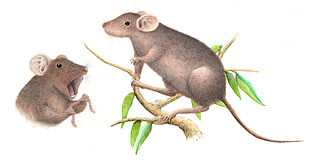
The large Mindoro forest mouse is a species of rodent in the family Muridae, from the genus Apomys. It is found only in the Philippines. Its natural habitat is subtropical or tropical moist montane forests. It is a large mouse with large feet, a long tail and an elongated snout which is morphologically unique within its genus. It is covered in soft fur which is mostly dark brown in colour. Its closest relative is thought to be the Luzon montane forest mouse, based on genetic and morphological similarities.

The Large Luzon Forest Rat, or Luzon Forest Rat is a species of rodent, the first of three to be described in the genus Bullimus. It is in the diverse family Muridae. It is found only in the Philippines. The rat has been recorded in Aurora, Benguet, and Camarines Sur provinces, and in Balbalasang, Kalinga province.
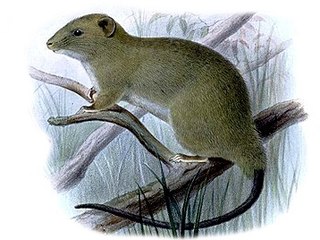
The short-footed Luzon tree rat or greater dwarf cloud rat is a species of rodent in the family Muridae. It is found only in the Philippines, specifically in northern Luzon. Its natural habitat is tropical moist montane forests.

The Dinagat bushy-tailed cloud rat, Dinagat crateromys or Dinagat cloud rat is a species of cloud rat in the family Muridae. It is one of the eight cloud rats found only in the Philippines, and is specifically endemic to Dinagat Island. It is known locally as hawili. A single specimen was discovered in 1975 by Dioscoro S. Rabor and his team during a scientific survey in Dinagat. The natural habitat is tropical lowland forests, which are facing environmental threats. Habitat loss is caused by progressive deforestation from heavy logging and chromite mining in the area. Almost 40 years after the original discovery, five live specimens were discovered by Milada Řeháková, Václav Řehák and William L.R. Oliver, in 2012.
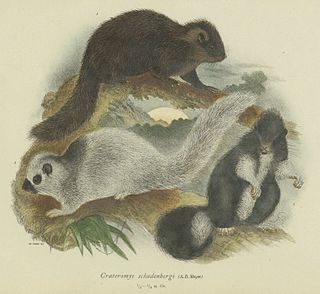
The giant bushy-tailed cloud rat or Luzon bushy-tailed cloud rat is a large, endangered species of rodent in the family Muridae. It is only found in pine and mossy forest at altitudes of 2,000–2,740 metres (6,560–8,990 ft) in the Central Cordillera of Luzon, the Philippines. Relatively little is known about its behavior, but it is nocturnal, mainly arboreal and feeds on various types of vegetation.
Oligoryzomys magellanicus, also known as the Patagonian colilargo and the Magellanic pygmy rice rat, is a species of rodent in the genus Oligoryzomys of the family Cricetidae. It is found in the southernmost parts of Argentina and Chile, including Tierra del Fuego and other outlying islands. Its karyotype has 2n = 54 and FNa = 66.

The southern giant slender-tailed cloud rat or southern Luzon giant cloud rat, also known as bugkon in Filipino, is a vulnerable species of rodent in the family Muridae, found only in southern Luzon in the Philippines. It is dark brown, occasionally with some reddish, but lacking the light-coloured sections usually seen in its close relative, the northern Luzon giant cloud rat. The southern giant slender-tailed cloud rat is a large rodent that has a total length of about 67–75 cm (26–30 in) and weighs 1.45–2.1 kg (3.2–4.6 lb).

The northern Luzon giant cloud rat or northern Luzon slender-tailed cloud rat, also known as bu-ot in Filipino, is a large species of rodent in the family Muridae. It is only found in Luzon, the Philippines.

Hydromyini is a very large, diverse tribe of muroid rodents in the subfamily Murinae. They are the dominant native rodents in Australasia and one of only two native rodent groups there, the other being the R. fuscipes group of the genus Rattus in the tribe Rattini. They are also found in parts of Southeast Asia.

Rattini is a very large, diverse tribe of muroid rodents in the subfamily Murinae. They are found throughout Asia and Australasia, with a few species ranging into Europe and northern Africa. The most well-known members of this group are the true rats, several species of which have been introduced worldwide.
